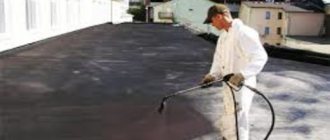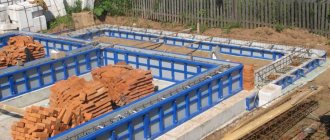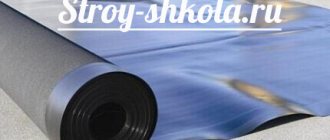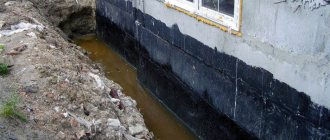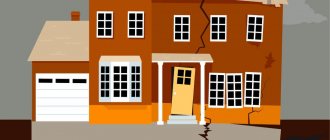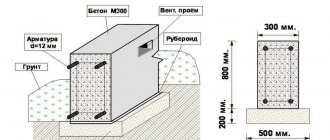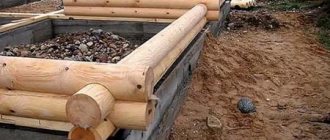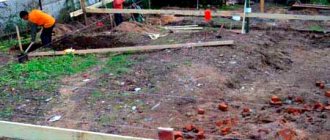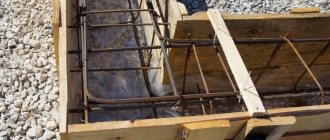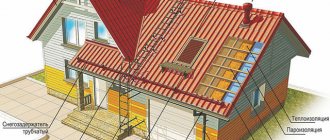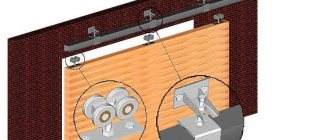In order to protect the reinforcement frame, as well as increase the durability and reliability of the foundation of the house, the foundation should be waterproofed. Otherwise, moisture will seep through the porous structure of the concrete. This threatens:
- The appearance of microcracks;
- Accumulation of water in the underground part of the building;
- Rusting of fittings;
- Reducing the duration of operation of the building.
Based on the above, it should be recognized that installing foundation waterproofing is a more than justified undertaking. It is advisable to combine it with the protection of the basement walls and then, upon completion, it will be warm and dry.
When to use horizontal waterproofing
Each surface of the object is insulated to create protection against getting wet. For this purpose, all structural elements are carefully insulated and protected with various materials. Waterproofing work is carried out on the foundation, plinth and blind area - those elements that, in contact with the walls, can transfer accumulated moisture to the base materials.
As a result of this, mold and mildew form, the bond in the seam areas is broken, cracks appear, and the object begins to slowly collapse.
Horizontal waterproofing of the foundation with materials intended for this work reliably protects the base and base from water entering porous areas of the concrete surface.
In addition, maximum protection of the building’s structural elements from the negative effects of ground moisture is created.
Horizontal waterproofing of any foundation must be carried out in strict accordance with the requirements established by SNiP. All work is carried out with reliable moisture-proof materials, attached to the foundation base, ensuring the sealing of seam, joining and gap areas.
Details
Why is horizontal waterproofing used?
Protection of any type of building surface is required in order to reliably protect it from the ingress and absorption of moisture. It is for this reason that the structural components of the building will be carefully insulated and protected using various materials. Work is being carried out to arrange the foundation itself, the blind area and the plinth.
In contact with load-bearing walls, such elements can transfer accumulated moisture to the base material. As a result, horizontal waterproofing of the foundation will help protect everything from the formation of fungus, mold, disruption of connections between seams, the appearance of cracks and the slow destruction of the house as a whole. This also helps protect the basement and foundation from liquids entering the concrete pores.
Moreover, this way you will achieve maximum protection of the extension elements from the aggressive effects of groundwater. According to SNiP (building codes and regulations), the technology of the insulation process must be strictly followed. The work requires the use of durable waterproof materials, which must be attached to the base with 100% sealing of joints, seams and gaps.
Horizontal insulation methods
There are several effective ways to do the work:
Cover type protection. It includes the use of roll materials/products based on bitumen. Most often used to protect wooden houses, but sometimes used to horizontally insulate the base of a house for any type of construction. For work, a simple roofing material is most often used, which can be glued to bitumen mastic. It is not advisable to use roofing felt on your own. When adding mastic, the quality of the layer, as well as the strength characteristics, increase several times. Rolled materials are laid with an overlap in a couple of layers to make the coating more reliable. Pre-prepared roofing felt sheets of specified dimensions are placed on pre-applied mastic with a thickness of 0.1 cm. All seams must be carefully sealed.- Coating protection. A horizontal type waterproofing device for the base involves the use of polymer materials, sprayed substances, liquid rubber, bitumen mastic or rubber. The insulator is evenly applied to a horizontal plane and distributed over the area as best as possible. The resulting layer will perform the function of repelling moisture and creating a rather thin, but durable and elastic film on the surface. After the polymerization process, it does not have capillaries or pores in its structure, which means there is simply nowhere for moisture to get.
- Penetrating type of insulation. It will consist of treating the base body with specially developed primer compounds. They need to be sprayed over the surface, and after that the substance molecules will penetrate deep into the base and fill the concrete pores. Creating an impermeable and reliable coating with a huge internal adhesion to the concrete component of the base.
Any method can be used, and if the technology is followed and the materials are correctly applied and fastened, a high degree of protection of the building from various aggressive influences is achieved.
Installation steps for roofing felt
This process involves the creation of a solid and single impermeable layer that reliably protects the base. Horizontal type waterproofing for the base using roofing material occurs as follows:
- The foundation walls must be marked and demarcated in advance.
- A screed is made from cement mortar.
- Cover the hardened composition with a layer of bitumen-type mastic.
- Each sheet of roofing material must be coated with mastic and glued to the foundation in such a way that the material fully covers the surface of the foundation and its side parts.
- The roofing material must be carefully leveled; wood floats are used so that the layer of glue, namely mastic, is evenly distributed over the entire area of the insulator and eliminates the appearance of voids.
Isolating the base using rolled materials makes it possible to prevent liquid from entering the basement floor and will prevent contact between the load-bearing walls and the plane of the base.
Materials used for waterproofing
Measures to waterproof the foundation from the walls are carried out with special materials, which include:
- waterproofing It is used as a sheet building material; its technical parameters are similar to those of roofing felt;
- glass insulation They protect the foundation thanks to the fiberglass found at the base of the material and considered a moisture-resistant component;
- hydroglass insulation Its main structure consists of elements included in the first two types of material. Apply by gluing or heating with a torch;
- glassine Slightly different from other materials, because it is based on oil-impregnated cardboard;
- roofing felt It can be ordinary or high quality, manufactured according to European standards. The most optimal option for private developers, acceptable in terms of quality and affordable;
- materials containing bitumen resin. There are no pores in such waterproofing materials; after heating, application and hardening, a thin moisture-proof elastic film is formed on the reinforced concrete surface;
- technoelast. Roll material, which is an excellent protection against the formation of fungal mold on the foundation surface;
- polymer-based membranes. They have a long service life, lasting up to fifty years. They create excellent protection for the foundation, but are highly susceptible to damage from mechanical influences;
- liquid rubber. Its main advantage is that after application to the surface the material does not form seams, the insulation is uniform and homogeneous in structure;
- uniflex. This product has a foil base. In addition to the protection function, the material reflects thermal energy well, preventing it from escaping from the building;
- elon. The base is made in 2 layers, perfectly resists changes in temperature conditions, and is able to withstand radioactive substances;
- benite mat. Mineral insulator, which is an environmentally friendly material and is considered very reliable;
- dry mixture. Rarely used, it is based on cement material. Similar compositions include Penetron, Calmatron and Hydrotex.
Using any of the mentioned materials, you will successfully cope with the installation of horizontal waterproofing of the foundation.
DIY waterproofing
You can waterproof your foundation yourself in several ways. The simplest and most reliable method to protect the foundation walls and its foundation is the use of penetrating waterproofing mixtures
.
The advantages of penetrating concrete additives are the ease of preparation of waterproofing from water and the ability to eliminate contact with more toxic and easily soiled bitumen compounds .
By turning into a crystalline substance, they prevent the penetration of moisture and corrosion of the material by caustic substances. Concrete becomes more durable and resistant to chemical and water exposure. His susceptibility to these substances becomes 4 times less. Frost resistance increases significantly.
Materials for foundation waterproofing
Penetrating mixture “Pronitrate Mix”
added to water to prepare a concrete solution (in a ratio of dry mixture: water - 1: 1.5). The solution itself is mixed using standard technology. The product consumption is 4 kg/m3 of concrete.
Tools and equipment for penetrating waterproofing:
- gloves;
- Master OK;
- bucket;
- concrete mixer;
- shovel.
DIY foundation waterproofing scheme using Penetrat
Penetrat Hydro system
applied to walls outside or indoors, providing a surface and penetrating waterproof layer.
The use of the product is preceded by thorough surface preparation, aiming at maximum adhesion of the drug and its deep penetration. The system consumption is 200-300 g/m2 of surface.
Preparing the wall for treatment with GS "Penetrat Hydro":
- removing mortar and building material residues from the surface;
- cutting seams with a jackhammer to a depth of 10-20 mm;
- thorough cleaning from residual dirt and dust; - saturation with water (5 liters of water per 1 m2 of surface);
- applying the system until a mirror surface is obtained (in 2 layers, with an interval of 24 hours between layers).
Do-it-yourself foundation waterproofing is ready!
Further finishing of the wall is possible a week after completion of the treatment.
Compliance with the basic requirements for waterproofing work allows you to obtain a building that is resistant to the action of melt and groundwater. The use of high-quality protective compounds “Penetrat” leads to maximum waterproofing effect during the construction of building structures, as well as the treatment of finished surfaces. Read more about the use of GS Pronitrate Mix and GS Penetrat Seam here
.
Types of waterproofing and technology for performing work
There are several ways to protect the foundation from the negative effects of water, which include:
- roll and pasting materials applied to the prepared base;
- impregnation and injection option.
Rolled types of materials, lining and surfacing compositions are applied before the construction of walls begins, while impregnating and injection compositions are allowed to work even during the operation of the facility.
Rolled and pasted
When constructing such waterproofing, bitumen or polymer-based materials are used, which are characterized by increased strength. The rolled material is directly fixed to the upper foundation edge.
The technology for its application is as follows:
- the surface of the foundation is covered with resin-based soil (primer);
- as soon as the primer is absorbed, polymer mastic is applied to the surface in layers, while the outer and outer corner areas are treated with special care;
- before applying roofing felt or other similar material, the bitumen layer should not have time to dry - the first layer is applied to fresh mastic;
- if a weldable material is used, its bottom layer is preheated, after which the waterproofing material is applied to the bitumen and smoothed with a roller to remove air bubbles.
To ensure reliable horizontal waterproofing of foundation walls, it is recommended to apply lining materials in several layers.
Penetrating
This method of waterproofing a reinforced concrete base involves the use of cement compositions with the addition of modifier components. Interacting with the concrete surface, they form crystals, creating a durable moisture-proof layer that perfectly resists the negative effects of moisture and chemical compounds. This waterproofing option is considered affordable, but requires preliminary preparation.
The algorithm for applying coating materials is as follows:
- the concrete surface is cleaned of mortar residues, dirt, rust, dust, paint stains, and old waterproofing coating are removed. Fatty areas are treated with hydrochloric acid. The foundation must be strong, with open porous areas, and the reinforcing bars must be thoroughly cleaned. Joining places, seam areas and cracks are opened and also cleaned;
- the cement-based solution is mixed with modifiers in accordance with the instructions;
- the concrete surface is moistened to improve adhesion and allow the mortar mass to penetrate deeply into the base;
- The mortar mass is applied with a spatula, leveled and left for two to three days until it dries completely.
This method of waterproofing will significantly increase the water resistance of the concrete surface, so it is recommended to use it not only during the construction of the facility, but also during repair work.
The installation of penetrating horizontal waterproofing of the foundation can be carried out with special solutions that have a low level of viscosity and are capable of penetrating deeply into the capillaries of concrete and forming a moisture-proof layer due to contact with the hardener.
As a rule, penetrating waterproofing from sprayed materials is combined with vertical protection during the construction of a building.
Injection
When repairing the foundation, they also use this method, which is based on filling porous areas of a reinforced concrete structure through pre-drilled holes. The level of penetration sometimes reaches fifty centimeters, and if there is contact with water contained in the foundation, the injection compositions swell and close the pores, thus preventing capillary absorption of liquid from the soil composition.
The technology for performing such protection looks like this:
- the internal and external surfaces of the foundation structure are cleaned of dirt and old waterproofing materials. The required number of holes is determined, which should be positioned in such a way that a continuous moisture-proof layer is formed inside the foundation;
- It is best to drill holes to a depth slightly greater than the width of the foundation base, while maintaining a slight inclined angle. Parkers are inserted into them - special nozzles through which the composite solution is evenly supplied;
- the composition is supplied by a low-pressure application unit, inside which a low-viscosity polymer gel is mixed with a hardening component. This process occurs immediately before the mixture is injected into the thickness of reinforced concrete, due to which deep absorption is achieved until hardening;
- impregnation is carried out until the pits are completely filled, then the parkers are removed and the holes are covered with sand-cement mortar.
As soon as the polymer composition hardens and swells under the influence of moisture, a completely moisture-proof layer is obtained.
What materials are best?
The most popular materials for waterproofing are:
- Gidroizol is an inexpensive rolled material similar to roofing felt;
- Stekloizol is a higher quality material with a longer service life. Installation is carried out by melting the inner layer using a torch;
- Gidrostekloizol is a material made on the basis of frame fiberglass or reinforced durable glass canvas coated with bitumen mass. This material is laid using mechanical fixation, gluing or melting;
- Glassine is a rolled material containing roofing cardboard impregnated with petroleum bitumen. Lay overlapping or joint to joint and glue with bitumen mastic, adhesive tape or tape;
- Ruberoid is a lightweight material made of roofing cardboard impregnated with petroleum fusible bitumen, with refractory bitumen applied to it, sprinkled with talc, asbestos, etc. This material is durable, but is very flammable, and also has low strength;
- Bitumen is a resinous or solid material made from a mixture of hydrocarbons and their derivatives. There are natural and artificial ones, the latter are used for waterproofing, due to the fact that they have a high softening point, frost resistance, elasticity, and have a viscous or hard consistency;
- Technoelast is a rolled material with increased biostability and reliability. Suitable for use in any conditions and climate zones. It is a weldable material, the fastening of which is carried out using a torch;
- Uniflex is a rolled material, also attached by reflowing with a propane torch. There are two brands: “K” - with foil or with coarse-grained topping on the front side, inside with a polymer film; “P” - with double-sided fine-grained coating or polymer film;
- Polymer membranes are a highly reliable and expensive material, the main disadvantage of which is their low resistance to mechanical damage. The service life of such waterproofing is about 50 years. To lay such material, a set of special tools is required;
- Elon is a 2-layer roll material. The top layer is a rubber membrane, the bottom is a non-woven synthetic base. It has high frost resistance and elasticity, durability, resistance to chemical and biological influences, including solar radiation.
- Benite mats are a reliable and durable material with a mineral base. Waterproofing made from benite mats is slightly susceptible to chemical and mechanical influences, temperature changes, and is also environmentally friendly;
- Liquid rubber is a progressive material for waterproofing, creating a single coating without seams or gaps. Liquid rubber is environmentally friendly and has high technical characteristics. Apply by spraying using special equipment. Service life - 20 years;
- Cement (calmatron, penetron, hydrotex, etc.) are dry cement mixtures. There are different brands:
- P - antifungal;
- U - universal;
- B - waterproof;
- B - fast-hardening.
When using cement mixtures for horizontal waterproofing, it is recommended to install a drainage system consisting of drainage pipes and a profiled membrane.
From theory to practice. A clear example of a moisture protection device is shown in the video:
Features of foundation waterproofing
The thickness of the insulating layer is determined by the material used. As a rule, the manufacturer indicates its parameters based on technical standards and features of each insulator. The thicker the layer, the better the quality of the work. But in this case, difficulties arise with sealing the seam areas. In addition, a thick layer loses its elasticity.
The recommended thickness of the protective layer against moisture is two to five millimeters.
When groundwater is located close to the surface and its pressure can create a significant impact on the foundation structure, you should not limit yourself only to lining materials. In this case, when creating horizontal waterproofing of the foundation, coating materials are applied to the concrete surface to create additional security.
When performing work, take into account certain parameters:
- the mass of the object fully influences the degree of depth of the base, and its location to the groundwater level and the freezing point depends on this;
- materials planned to form a moisture-proof layer;
- is there a need for additional measures to arrange the drainage system and blind area;
- Is there a waterproofing layer on the inner plinth surface?
Types of horizontal insulation
In construction, insulation of foundations from water ingress is carried out using the following methods:
- By laying rolled roofing materials.
- Coatings with impregnating compounds.
- Injections with special water-repellent emulsions and solutions.
Roofing waterproofing material is laid directly on the upper horizontal plane of the foundation before erecting walls.
Sometimes you can hear the opinion that penetrating and injection horizontal waterproofing of foundations can be done even during the operation of the house. If, for some reason, horizontal insulation was not installed at the construction stage, then, as a way out of this situation, it is possible to treat the horizontal surface of the foundation with penetrating compounds or perform an injection waterproofing treatment.
Carrying out such processes will require significantly more time and labor, so it is best to waterproof the foundation walls immediately during the construction of the house.
Diagram of horizontal waterproofing device
Horizontal impregnation insulation
Creating horizontal waterproofing by applying impregnating cement compositions with chemically active compounds is an inexpensive and effective way to create a protective waterproof coating. When applied to a concrete surface, concrete crystallizes and a hard surface layer is formed with increased resistance to erosion and aggressive external environments.
Instructions for creating penetrating insulation
Penetrating horizontal waterproofing compounds should be applied in the following order:
- The upper horizontal surface of the foundation is thoroughly cleaned of dust and dirt stains, rust and paint residues are removed and degreased with a solution of hydrochloric acid. Rusty fittings must be cleaned to a metallic shine and coated with an anti-corrosion compound. The prepared top part should have a smooth and durable surface with open pores.
- Typically, penetrating compounds are sold in the form of dry cement mixtures with fillers - modifiers, which are diluted directly on the construction site with water in the required proportion and according to the instructions.
- The prepared horizontal surface is generously moistened with water using flat brushes until saturated.
- The prepared penetrating solution is applied to the surface with wide steel spatulas and carefully leveled. Typically the applied mixture is left to dry for several days. Naturally, in case of rainy weather, the applied layer is covered from raindrops with PVC film.
Application of impregnating waterproofing
Recently, special polymer two-component solutions with improved waterproof properties have appeared on the modern market of construction waterproofing materials. Possessing low viscosity, polymer mixtures penetrate deeply into the concrete body, fill its capillaries and, after applying a hardener, create a reliable waterproof layer.
The application of penetrating mixtures significantly increases the water resistance of concrete foundations, which makes them popular and appropriate materials for new construction, repair and reconstruction of houses and structures.
